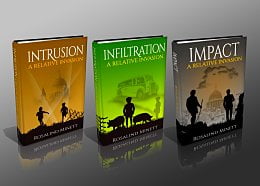
British indie author Rosalind Minett
While it’s currently received wisdom that writing books in a series gives the indie author a great marketing advantage, not all series are planned as such – sometimes they evolve from story, as British novelist Rosalind Minett discovered when writing her recently completed Relative Invasion trilogy. Her explanation of how it happened offers useful insights for any writerthinking about producing a series of three of more books.

A Relative Invasion took me far longer to complete than my Ph. did. Am I now a trilogist? No, because I didn't set out to write one, and ‘trilogist' sounds very iffy, like someone who studies rare flies.
A Relative Invasion is probably the only trilogy I'll write. It was meant as a novel.
Starting Out with One Novel
I began to write the story of a good-hearted boy, Billy, who was going to need all the resilience he could muster to weather the threat of war, and the threat of his manipulative cousin. A trilogy never entered my mind. I wanted to explore how the emotions that led to WWII might play out in micro, in a South London family. This was a story about rivalry.
What Happened Next
This is what happened:
- Billy was only five years old at the start of my story. At around the fifth chapter I knew what the ending must be, and I wrote that in full. I then returned to Chapter Five. Just a matter of getting Billy from that point to the end, but by the time I had written one hundred thousand words, he was still only seven. At that point I stopped, thinking I had better made the story into two books. Backtracking, I wrote a suitable ending to Book One, which came at around seventy-five thousand words.
- When Book Two reached a similar length, World War Two had just ended, but I was a long way from the climax. VE Day provided a natural conclusion. Billy was then twelve, and cousin Kenneth, thirteen. Adolescence and the terrible austerity of London's 1940s lay ahead, together with the fall-out from their life-long rivalry.
- Book Three had to bring the boys to adulthood, and by the time I'd written to that point, I was at one hundred and twenty thousand words. I could have started the boys' careers and made four books, but I had already been describing the previous books as part of ‘a trilogy'. I stuck to this, revised, cut Book 3 down to one hundred and five thousand words. After all, the climax and the ending were just as I'd planned.
Much advice on ALLi and elsewhere suggests that series work best for the indie writer. Is the same true of a trilogy? A trilogy suggests an entity like the three-movement sonata in music, or the triptych in art. The form must be complete, whereas the novelist has more freedom to finish where s/he likes, at any point, at any length.
Crucial Take-Away Points
What can I advise would-be trilogists as result of my labours?
- Early on, write a time-line. Put in the historic events, check exact dates of these. Ensure you record each character's date of birth, location, key events. In a trilogy, you may need to come back to them. Old incidents come back to bite the bottoms of the unwary.
- Write your real ending early on so that you retain a clear sense where your story is going. Ideally, mark out how much will happen in each book.
I'd also suggest the following about a trilogy:
- The story has to be substantial. It has to touch on something in human nature that will resonate meaningfully over the timescale of your three books so that the three do comprise an entity, not three stories about the same people.
- The flow of life needs to show: precursors in Book 1, developments in Book 2, outcomes in Book 3. In music the third part would be recapitulation. Outcomes do have this element: a reworking of earlier events. If there's a crisis in Book 1 it can resolve, but not really conclude there; longer-term effects should pop up in Books 2 or 3.
- There needs to be some sense of linear movement, even if the books are not arranged in chronological sequence. The reader will want to feel the size of the whole time span by the time s/he reaches the end.
- Include several fully-imagined characters. Three books are too many to focus on just one or two main characters. The work needs other characters with their own concerns for the main ones to knock against and react to. The range of possible interactions gives a more detailed picture of the protagonist(s) and a fuller character development.
- Similarly, there needs to be more than one theme. For instance, the main theme in my trilogy is the far-reaching effects of an ongoing childhood relationship. Connected to this is the theme of coming-of-age, bullying, parenting issues, the subtler effects of war service, a re-examining where personal responsibility lies.
- Although the trilogy will follow one arc (mine was before war began until war effects ended – “You've never had it so good”), each book also needs its own arc. Mine fell into line with historic events: threat of war until its onset; the war years; post-war austerity. Each marked great changes in Billy's life.
- It's these changes that make for a satisfying place to end one book and start the next.
Finally, you need to be a sticker; someone with a persistent, resilient personality who does not give up what they have started. I wrote these traits into my main character, and he helped me to stay the course.
OVER TO YOU If you’ve written a trilogy, do you have any advice you’d like to add to Rosalind’s list? Is three a magic number for a series, or are you pursuing a different plan for your series?
Top tips for writing and #selfpublishing a #trilogy – by @MinettRosalind Share on XOTHER HELPFUL POSTS ABOUT WRITING




This is a big help, thanks for sharing, Rosalind.
I have one tip to share. Titles play an important role in determining your readership. To hook many readers, each of the book in your trilogy should have an intriguing and compelling title. Each title should give the readers an idea on what the installment is about and on what they can expect from the story. These titles should hint at pivotal plot developments in each book. The purpose for this is to sustain the interest of the readers in your trilogy. By choosing the right titles, you are somewhat assuring the readers of the consistency of your overall story. The consistency and relevance of your titles as well as your stories are crucial in maintaining your readership. The more relevant and consistent to the overall theme your titles are, the more readers will be convinced to read your trilogy until the last installment. Although they do not seem significant at first, titles are actually an important consideration in writing a trilogy.
[…] Top Tips for Writing a Trilogy […]
[…] Top Tips for Writing a Trilogy […]
Thank you Rosalind
I didn’t set out to write a trilogy, either. My subject was the biographical life of the ‘Mona Lisa’. Not the painting but the woman in the painting as being Leonardo da Vinci’s half-sister, and wholly separate from another painting of the silk merchant’s wife, Lisa Giocondo.
The only biographical information about Leonardo’s historical sister, was a single reference in a census report. Since her name was Lisa (Lisabetta) I premised she was the original subject of a pair of portraits – two Lisas painted simultaneously. There is historical evidence that supports this. As an art history major, that premise was enough to hook me.
I wrote a parallel story of an autistic child (in the present day) visiting the Louvre who spoke with Lisa’s spirit trapped in the ‘Mona Lisa’. His and his single mother’s story expanded the concept of two individual s with a similar identity crisis. Lisa and the boy must work together to be visible and acknowledged.
Eventually, I self-published in one volume, but it was a huge doorstop of a book that weighed heavily with formidable shipping costs, and being a new author, it was priced too high for anyone to take a risk on an unknown. I share the same invisibility challenge as a woman in Leonardo’s time.
And so, I divided my story into three volumes (Lisa’s childhood, her apprenticeship with her brother, and middle age) and rewrote the transitional endings of book 1 and 2.
I write long. But then, regardless of the publishing rules, I think certain stories require depth and length. The historical details had to be correct, and since the Italian renaissance is a rich subject, it grew exponentially… with no info dumps, as new characters emerged.
Since that debut novel, I’ve written three single-volume stories, a two-book novel, and begun a three volume series for middle-grade.
In my opinion, authors are best writing what feels compelling rather than to market. I visualize all my stories as television series, not from manipulation or pie-in-the-sky but from an interesting set of characters involved in a story that doesn’t stop at 300 pages.
Your trilogy sounds wonderful. A must read. That wartime period reminds me of a fascinating television series ‘Family at War’. Thank you again. It cheers me to read of your success.
Thank you, Veronica. I connect with your development of such an interesting theme. I,d have divided it the same way. I’m sure there are many readers of lit tic who would relish such books, and be attracted by Leonard’s presence anywhere.
Thanks also, Daniel. I’d say it was essential for main characters in Books 2 and 3 to appear notably in Book One so that they were already ‘known’ by readers even if their lives were not explored much.
This is a tremendous help to me, Rosalind, as I struggle with Book 2 of my historical trilogy. The overall time span is just two years but I’ve crammed a lot of plot turmoil and character evolution into it. Having finished and published Book 1, I’m doing a re-hash similar to yours. I’m boiling down 260,000 words from two rewrites of the same idea, into a trilogy of 112K, 90K and 85K.
As you advise, I find it helpful that I already have the endings for Books 2 and 3 in at least first draft form. The difficulty in moving my main character and her love interest through the remainder is choosing which supporting cast to develop so that their story arcs might carry the overall arc to satisfaction. As you mention, the interesting supporting characters introduced in Book 1 offer great potential for further treatment in 2 and 3.
With 50% of the material for Books 2 and 3 already “snatched” from the old trunk novel, I think I can make rather quick work of them, but I’m not kidding myself about the chapters not yet begun. The trick for me will be to select a path and stick to it.
Your post is both a validation of steps I’ve already taken and an offering of helpful signposts by which to measure my future efforts. Thanks for sharing your journey.